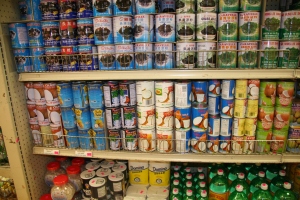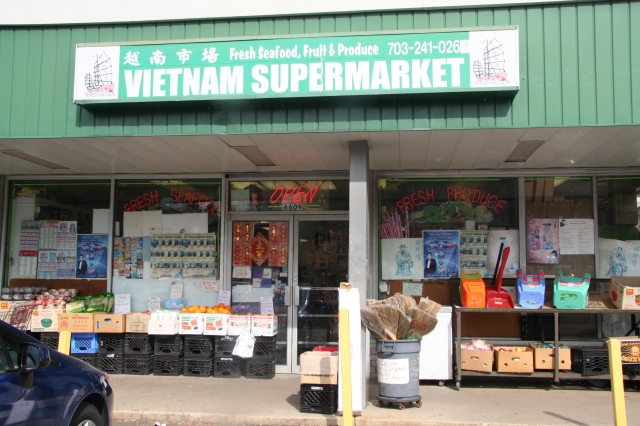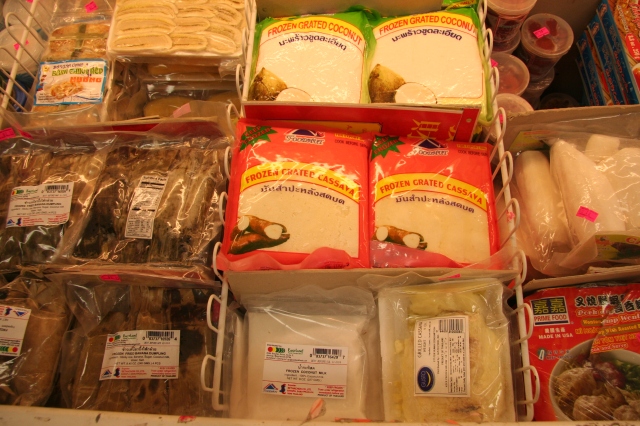 Coconut has long been a staple food in tropical regions around the world and has grown in popularity in America. This is thanks in part to Americans’ growing interest in the exotic flavors from countries like Thailand, India and Brazil. But it is also thanks to the growing body of research on coconuts’ nutritional benefits (a good resource is the Coconut Research Center). Luckily it’s pretty easy these days to find good quality whole coconuts, shredded dried coconut meat and coconut oil. Unfortunately coconut milk is another story.
Coconut has long been a staple food in tropical regions around the world and has grown in popularity in America. This is thanks in part to Americans’ growing interest in the exotic flavors from countries like Thailand, India and Brazil. But it is also thanks to the growing body of research on coconuts’ nutritional benefits (a good resource is the Coconut Research Center). Luckily it’s pretty easy these days to find good quality whole coconuts, shredded dried coconut meat and coconut oil. Unfortunately coconut milk is another story.
Do you buy canned or boxed coconut milk or eat at restaurants that cook with these products? Ever wonder what all those extra ingredients in the can are? Do you want to know where to find pure, fresh-tasting and additive-free coconut milk without having to make it yourself?
First, a Word About FRESH Coconut Milk
By far, the BEST coconut milk is the kind you make yourself, from freshly grated coconut. Unfortunately that is time and labor-intensive. But so is guacamole, yet even the busiest of my friends (even those who claim not to enjoy cooking) occasionally whip up a fresh batch. Why? Because avocados are extremely perishable and the difference in flavor between fresh avocado and *any* packaged version is huge. The same is true for coconuts.
This is why most coconut milk sold in stores contains sodium metabisulfite (click on the image to zoom in).
 That’s a chemical preservative which is also used in wine (see this post on wine and sulfites). So what’s wrong with this substance? Check out this data sheet from one of its producers. After the OSHA warning that it’s a hazardous substance, it says that ingesion in small quantities may cause gastric irritation and that larger quantities “may produce violent colic, diarrhea, circulatory disturbance, depression of vital functions and, sometimes, death.” Even though a single can of milk contains only a little bit of this chemical, it worries me to think about the cumulative effect of 20+ years of consumption.
That’s a chemical preservative which is also used in wine (see this post on wine and sulfites). So what’s wrong with this substance? Check out this data sheet from one of its producers. After the OSHA warning that it’s a hazardous substance, it says that ingesion in small quantities may cause gastric irritation and that larger quantities “may produce violent colic, diarrhea, circulatory disturbance, depression of vital functions and, sometimes, death.” Even though a single can of milk contains only a little bit of this chemical, it worries me to think about the cumulative effect of 20+ years of consumption.
Organic (Canned) Coconut Milk
What about canned “organic” coconut milk? Even if they don’t contain sodium metabisulfite, almost all of them contain guar gum. What’s that, you ask? The food industry uses its standard party line, which goes like this, “guar gum is a ‘natural’ thickener that is made by grinding the endosperm of the guar bean.” As with all food additivies as well as many drugs, they all start with an ingredient found in nature. High fructose corn syrup (recently renamed as “corn sugar”) is supposedly also a natural sweetener that is made “using starch that is extracted from kernels of corn.” What everyone is leaving out of the story is the downstream chemical and other refining steps these products go through before they end up on store shelves. It’s those processing steps that often lead to health problems. But even if it were ok to ingest food-grade guar gum (which I’m not convinced it is), I hate that the manufacturers are fooling consumers by masking the natural thickness (or more like thinness) of their coconut milk. This makes it hard to figure out the actual concentration of coconut vs. water or other additives. It’s the same reason companies started homogenizing milk (so you couldn’t tell how much cream was in there) and adding yellow food coloring to butter (so you can’t tell whether the cow was eating fresh, spring grass or something else).
BPA in Coconut Milk Cans
My second complaint with canned coconut milk is the BPA that’s present in the plastic that lines most cans. BPA is easily leeched into fatty products, like coconut milk, and even more so when the plastic is heated, as happens in the canning process. Some brands claim to line their cans with non-BPA containing plastic, but I believe that’s misleading. This article talks about how so-called “BPA-free” products still contain toxic bisphenol. I’ve always wondered why coconut milk doesn’t come in glass jars. Traditionally that’s how canning was done. The problem is the extra weight and breakage risk in shipping.
The third reason I don’t like canned coconut milk is because it’s cooked. That’s how canning works. But there are times that I would prefer my coconut milk raw, especially for desserts, because it tastes entirely different, just as cooked avocado tastes nothing like the raw fruit.
My Choice For The Best Pre-Packaged Coconut Milk
The brand I trust most is available at Vietnam Supermarket, near the Eden Center in Falls Church, VA, near Seven Corners.
 The distributor tells me that it’s also available in the DC metro area at Bien Hoa and Han Ah Reum, both in Falls Church. Once in the store, you have to go to the freezer section. Or ask an employee to help you find it.
The distributor tells me that it’s also available in the DC metro area at Bien Hoa and Han Ah Reum, both in Falls Church. Once in the store, you have to go to the freezer section. Or ask an employee to help you find it.
The brand is Foodhut. It’s produced in Thailand by Sethachon Company Ltd. One 8oz pack costs $2.50 at Vietnam Supermarket.
I trust this brand more than the canned variety for several reasons. First of all, the ingredients label has only one ingredient – coconut milk. Secondly, it’s frozen and warns the buyer to “Thaw under refrigeration immediately before use.” In other words, it’s perishable, just like fresh coconut milk. That said, I did learn from the distributor that it is flash pasteurized. This is now a requirement for many imported foods. Not ideal, I know, but still better than the intense “cooking” that canned products go through. The third reason I like this coconut milk is because it tastes fresh and coconutty, which makes it ideal for desserts, smoothies and drinks (pina colada, anyone?).
The biggest downside of this product is that it’s not suitable for every use. Unfortunately coconut milk doesn’t take that well to freezing. After thawing, it looks a little bit grainy.
 Don’t worry, it doesn’t taste grainy. Nevertheless, the coconut milk just doesn’t cook the same after it’s been frozen. It unsuitable for high temperature cooking or even long cooking at low temperatures. So you won’t get good results for dishes that are baked with coconut milk. It also won’t thicken your soup or sauce liked canned coconut milk does – remember, there’s no guar gum! However, this coconut milk works great if you add it to a dish at the end of cooking. If you want to use it for a thick curry, just be sure you’ve thickened the curry another way, for example, by cooking down tomatoes until thick. This coconut milk is also good for taming an overly-spiced soup or curry. I only know that because I frequently get a little carried away with the cayenne pepper and then regret it. A single pack of this coconut milk has always saved me!
Don’t worry, it doesn’t taste grainy. Nevertheless, the coconut milk just doesn’t cook the same after it’s been frozen. It unsuitable for high temperature cooking or even long cooking at low temperatures. So you won’t get good results for dishes that are baked with coconut milk. It also won’t thicken your soup or sauce liked canned coconut milk does – remember, there’s no guar gum! However, this coconut milk works great if you add it to a dish at the end of cooking. If you want to use it for a thick curry, just be sure you’ve thickened the curry another way, for example, by cooking down tomatoes until thick. This coconut milk is also good for taming an overly-spiced soup or curry. I only know that because I frequently get a little carried away with the cayenne pepper and then regret it. A single pack of this coconut milk has always saved me!
Some Wonderful and Exotic Recipes to Try
Senegalese Peanut Soup: My recipe is a variation on the recipe in James Peterson’s Splendid Soups. Sautee 1 chopped onion, 1 diced sweet potato, 2 garlic cloves and 1/8-1/4 tsp cayenne pepper in clarified butter until translucent, 10 min. Add 2 TBSP garam masala and stir for another minute. Add 3 cups water or chicken broth and 10 roughly chopped tomatoes with seeds squeezed out. Simmer for 10 minutes or so, then puree everything with an immersion blender. Add 2/3 cup freshly ground peanut butter (I get mine from Whole Foods) and 1 package of the Foodhut coconut milk. Season with salt and pepper, garnish with cilantro, and serve with a wedge of lime.
Burmese Mohinga Soup: I first discovered this fascinating soup at Burma Super Star restaurant in San Francisco and have been hooked ever since. There are lots of recipes online for this soup, which I’m told the Burmese typically enjoy for breakfast. Here is one such recipe: http://www.guardian.co.uk/lifeandstyle/2012/feb/24/burmese-mohinga-soup-recipe. By the way, “gram flour” can be easily made by buying dried yellow split peas from an indian or other asian market and then grinding them in a spice grinder or mortar and pestle.
Tom Kha Gai: This well-known soup will require a trip to a Thai market for ingredients, but it’s well worth it. Do not use a jarred or canned spice paste because it’s loaded with MSG, even if it doesn’t appear to be from the label. I make mine by heating up homemade fish stock or shellfish stock. Then I add slices of galangal root (ginger works too) and smashed stalks of lemongrass and a few kaffir lime leaves. After infusing all of those together for about 10 minutes, I strain these ingredients out and add sliced mushrooms, bell pepper slices, bird eye chiles (or serrano peppers), sliced shallots and some fish or shrimp to the broth. I sometimes also add some pieces of chicken meat – leftovers are great here and cherry tomato halves. Once the veggies are cooked through, I turn the heat off, add several glugs of good quality fish sauce, lime juice and chopped cilantro along with a packet of the coconut milk.
Moqueco – Brazilian Fish Stew: Here’s a good recipe: http://www.simplyrecipes.com/recipes/moqueca_-_brazilian_fish_stew/. Just remember to add the coconut milk at the very end, after the heat is turned off.
Pineapple Coconut Juice:In between a juice and a smoothie. Just puree the half-thawed coconut milk with pineapple chunks in the blender. So simple!
Mango Coconut Smoothie: Same as above, but use fresh mango instead of pineapple.

